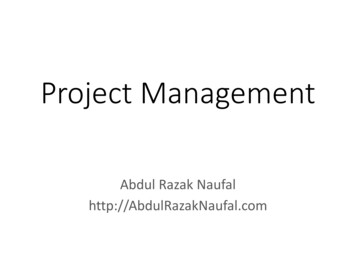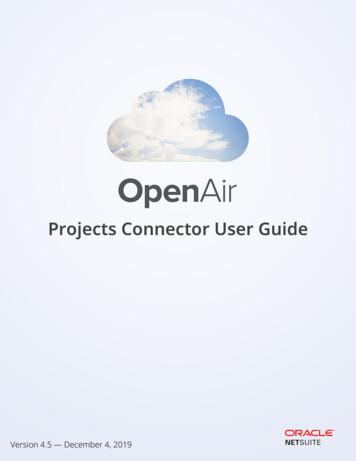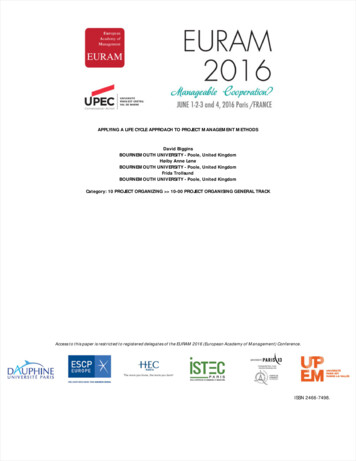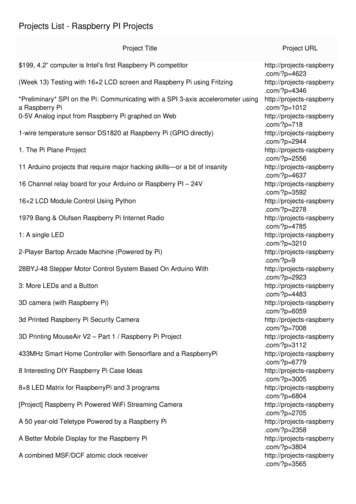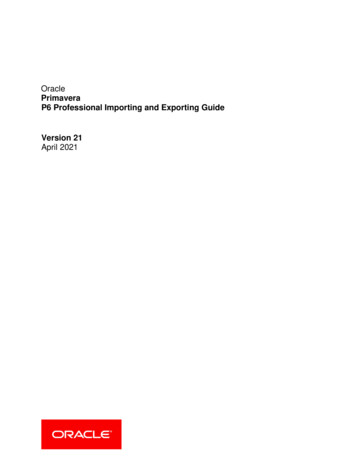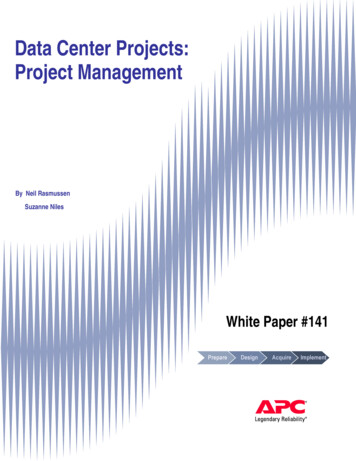
Transcription
Data Center Projects:Project ManagementBy Neil RasmussenSuzanne NilesWhite Paper #141
Executive SummaryIn data center design/build projects, flaws in project management and coordination are acommon – but unnecessary – cause of delays, expense, and frustration. The ideal is forproject management activities to be structured and standardized like interlocking buildingblocks, so all parties can communicate with a common language, avoid responsibility gapsand duplication of effort, and achieve an efficient process with a predictable outcome. Thispaper presents a framework for project management roles and relationships that isunderstandable, comprehensive, and adaptable to any size project. 2007 American Power Conversion. All rights reserved. No part of this publication may be used, reproduced, photocopied, transmitted, orstored in any retrieval system of any nature, without the written permission of the copyright owner. www.apc.comWP141 Rev 2007-02
IntroductionIn a project to build or upgrade data center physical infrastructure, a structured and standardized processprovides the essential foundation for efficient project execution and a successfully deployed system. Amodel for such a standardized process is described in APC White Paper #140, “Data Center Projects:Standardized Process.” A major element of this standardized project process is project management, whichguides the project through its various phases and coordinates the work of all parties to the project.Even if a project is being led by an experienced consulting firm, there will be other parties to the project – theend user, various hardware or service providers, a general contractor – who have a role in the managementof project activity. The responsibilities and interrelationships among these various contributors must becoordinated and documented in order to avoid dropped handoffs and ambiguous responsibility. Suchproblems are not necessarily due to flaws in the activity of the parties involved, but rather to the lack of anoverarching, shared process guiding all parties as a management team, clarifying accountability andcommunication.As data center build and upgrade projects move away from art and more toward science, projectmanagement must be re-examined using the same principles as the rest of the process. Just as the stepsof the project work should be structured and standardized to simplify and streamline the process, it is equallyimportant that project management activities be structured and standardized. The benefits of a welldocumented, standardized, and mutually understood project management model are similar to the benefitsobtained from the rest of any standardized process model:A common language. When all parties to project management are operating from the samemodel, using the same terminology to refer to same things, many problems caused bymiscommunication and different viewpoints are eliminated.Transparent terminology. With management roles having names that clearly represent what theydo, another cause of miscommunication is eliminated.Clear delineation of responsibilities. A mutual understanding of who is doing what clarifiesrelationships and avoids duplication and conflict.Complete coverage of necessary activities. A carefully designed model ensures that allmanagement responsibilities are accounted for, and nothing “falls through the cracks.”This paper presents a model for management roles and the relationships among the project managementactivities of the end-user (the customer) and the various suppliers of products and services for the project. Itdoes not attempt to describe project management techniques – rather, it describes a framework for thestructure of a standardized model and terminology for project management in data center design/build 2007 American Power Conversion. All rights reserved. No part of this publication may be used, reproduced, photocopied, transmitted, orstored in any retrieval system of any nature, without the written permission of the copyright owner. www.apc.comWP141 Rev 2007-03
projects. This model can be adapted according to the preferences of the user/customer and the specificrequirements of the particular project.Configuring Project Management RolesIn the standardized model of the project process, project management is a broad category of oversightactivity that occurs throughout the course of the project to provide communication, planning, coordination,and problem resolution (Figure 1).Figure 1 – Project management in the project process mapPHASESPrepareDesignAcquireImplementProject ManagementSTEPSAssess NeedsInitializeProjectShipmentAssemblyDevelop ConceptEstablishRequirementsSite CoordinationInstallation bySubcontractorsConfigure SolutionStart-upFinalize ProposalNetworkIntegrationCreatePurchase OrderOrientationand TrainingFor more about this process map, see APC White Paper #140,“Data Center Projects: Standardized Process”As with any business project, data center project management provides dedicated oversight to addressproject-critical activities such as Scheduling Resources Scope of responsibilities Continuity (handoffs) Budget System changes Process defects Status reporting 2007 American Power Conversion. All rights reserved. No part of this publication may be used, reproduced, photocopied, transmitted, orstored in any retrieval system of any nature, without the written permission of the copyright owner. www.apc.comWP141 Rev 2007-04
General techniques, training, and tools for project management are well documented in business andindustry literature, and are beyond the scope of this paper. This paper focuses on the particular projectmanagement roles needed for data center projects, and how those management responsibilities can bedivided up and accounted for, in order to meet the needs of a specific project. Determining whichmanagement roles are needed for the project, and who will perform them, is part of configuring the processfor the project at hand. The proper configuration of the process is as important to the success of theproject as the configuration of the physical equipment of the system.When does “project management” start?The configuration and delegation of project management activity is a critical element of process design thatmust be considered and determined up front, well before the time comes to execute it. Depending upon thesize, scope, and clarity of the project initiative at the outset, assigned and dedicated management may notbegin until after the initial fact-finding activities of the Prepare phase, which identifies and clarifies theendeavor as a “project” (Figure 2). Note that the milestone defining the end of this first phase is Commit toProject, which typically marks the beginning of whatever tracking and database activities will be used tosupport the project, and in some cases may be the point at which formal “project management” starts.Figure 2 – For a typical data center project, project management should be configuredand ready to execute by the end of the Prepare phaseProject ManagementConfigure project managementroles and responsibilities duringPREPARE phaseFor most projects,project managementstarts no later than here()For very small projects,project management might notneed to start until here, afterP.O. is executedProjects of greater scope or with more customized engineering may require that project management activitybegin earlier – during the Prepare phase – whereas for smaller data center expansion projects, projectmanagement may not need to start until later, after the purchase order is executed at the end of the Designphase. The size, complexity, and criticality of the project will determine when “project management” needsto become a structured, dedicated role.Regardless of how and when project management is configured, there will always be some projectmanagement activity in the customer organization from the very beginning, if only to make the configurationdecisions and possibly negotiate contracts for outsourced management. This ongoing management role isshown as “customer-side project management” in Figure 7, later in this paper. 2007 American Power Conversion. All rights reserved. No part of this publication may be used, reproduced, photocopied, transmitted, orstored in any retrieval system of any nature, without the written permission of the copyright owner. www.apc.comWP141 Rev 2007-05
Subordinate management rolesThe general process map of Figure 1 shows project management as a single bar across the top, implyingthat it is one job. It can be one job, and in smaller projects it might be configured that way. More often it isconfigured as more than one job, or an oversight job with subordinate jobs under it. For example,“installation management” can be defined as a separate role spanning the Acquire and Implement phases,overseeing on-site activity related to delivery and setup of the physical system (Figure 3). Managementroles such as this should be considered modular elements of overall management, remaining subordinate tothe overall end-to-end project management role.Theoretically, management responsibility could be subdivided further by assigning separate management toeach of the four phases, or even to combinations of steps within a phase (not generally recommended, butit could be appropriate in special circumstances). More typically, management responsibility is subdividedby the organization(s) providing hardware and services – for example, APC or sub-contractors – not bysteps in the process model.At the most granular level, note that step management is already built into the process, as the “owner” that isassigned to each step (see “Anatomy of a Step” in APC White Paper #140, “Data Center Projects:Standardized Process.”)Figure 3 – Subordinate management roles, such as installation management,can be defined under the overall project management rolePrepareCommit toprojectDesignAcquirePurchase mpleteProject ManagementInstallation ManagementAssess NeedInitialize ProjectDevelop ConceptEstablishRequirementsSite CoordinationAssemblyShipmentInstallation bySubcontractorsConfigure SolutionStart-upFinalize ProposalCreatePurchase OrderNetworkIntegrationOrientationand Training 2007 American Power Conversion. All rights reserved. No part of this publication may be used, reproduced, photocopied, transmitted, orstored in any retrieval system of any nature, without the written permission of the copyright owner. www.apc.comWP141 Rev 2007-06
Dedicated point-of-contactRegardless of how project management responsibilities are configured, the objective of each managementrole is the same: seamless coverage within its scope of responsibility, integration with other managementroles, and a dedicated point-of-contact at all times. A dedicated point of contact is especially critical whenthe ultimate responsibility lies with delegated sub-roles or third party providers. Such a dedicated point-ofcontact, whose job it is to field, direct, and coordinate communication, should be considered an essentialrole in every project. For example, in APC’s implementation of the standardized project process (used toconduct the sale and execution of a customer project – see later section Project Management Detail)the “project commitment manager” is the dedicated point-of-contact for the project. This management rolemonitors and facilitates fulfillment of all commitments made to the customer – delivery dates, appointments,and other promises – during the course of the project, with authority to do “whatever it takes” to clearroadblocks and solve coordination problems.Documentation and trackingRegardless of how project management roles are configured for the project, an essential projectmanagement responsibility is documentation and tracking of project activity. Current project informationmust be easily accessible at all times to authorized project team members and service partners. A commonand effective method is an online Web site. This interactive project record should not only provide up-todate information, but it should also accept feedback, comments, requests, and problem statements, androute the information appropriately. The project database should be able to provide updates and reports,and log ad hoc information such as contractors’ vacation schedules, alternate phone numbers, andmiscellaneous remarks.Coordination of Multiple SuppliersMost data center projects will have more than one supplier of hardware or services contributing to the workof the project. The customer may engage separate equipment vendors or service providers for power,cooling, racks, security, fire suppression, electrical work, mechanical work, and perhaps a general contractorif building construction is required. Each supplier of hardware or services will have potential interaction ordependencies with the other suppliers to the project. For example, fire suppression installation dependsupon piping and wiring that must be installed first, both of which may be handled by a different supplier.While each of these suppliers will have its own “project manager” to conduct the work it contributes to theproject, there is an additional project role that spans all suppliers: coordination. Coordination provides aninterface among suppliers with whom there are equipment or time dependencies. It is a role that can bedifficult to assign when there are many suppliers to a project.If dependencies among suppliers are not coordinated, delays and expense can result from supplier sitevisits that are scheduled too soon for the handoff, or from one supplier unnecessarily waiting for something 2007 American Power Conversion. All rights reserved. No part of this publication may be used, reproduced, photocopied, transmitted, orstored in any retrieval system of any nature, without the written permission of the copyright owner. www.apc.comWP141 Rev 2007-07
from another. Coordinating the work of all suppliers is a critical part of project management that can beoverlooked in planning, but is essential to the efficient and reliable progress of the project.Minimizing the number of suppliers – for example, by bundling some services and equipment under a singlevendor – shifts some of the coordination burden to the intermediate vendor and reduces the risk of faultycommunication between suppliers (Figure 4). While it may not be possible to have everything handled by asingle vendor, reducing the number of vendors can significantly decrease the coordination burden,especially when all possible interdependencies are considered (Figure 5).Figure 4 – Bundling project elements under one vendorCoordination by customerCoordination by FireSuppressionMechanicalSubcontractorVendorof Equipment and ServicesDirect coordination withevery ysicalSecuritySome equipment and servicesbundled under one vendor 2007 American Power Conversion. All rights reserved. No part of this publication may be used, reproduced, photocopied, transmitted, orstored in any retrieval system of any nature, without the written permission of the copyright owner. www.apc.comWP141 Rev 2007-08
Figure 5 – Bundling project elements reduces coordination burden on the customerALL inter-elementcoordination by customerAppropriate for a smallproject with few elementsFire(e.g. wiring closet)CUSTOMERInter-element coordinationhandled by ontractorPowerInter-element coordinationhandled by VENDOR ofbundled elements and rityRacksa. All independent suppliersNO inter-elementcoordination bycustomerREDUCED inter-elementcoordination by customerCUSTOMERCUSTOMERSome coordinationhandled by vendorFireSuppressionGeneralContractorALL inter-elementcoordination handledby vendorVendorof Equipment and ServicesElectricalSubcontractorPowerVendorof Equipment and ecurityCoolingRacksb. Some elements suppliedby a single ecurityc. Vendor provides servicesto manage all other suppliersUsing Services for Project ManagementQualified service providers may be included in the project management configuration, to supply some or allproject management activities. Whether, how much, and to whom the organization decides to delegateproject management duties depends upon the nature of the project and the preferences of the organization.There are three general models for engaging external service providers in project managementresponsibilities: 2007 American Power Conversion. All rights reserved. No part of this publication may be used, reproduced, photocopied, transmitted, orstored in any retrieval system of any nature, without the written permission of the copyright owner. www.apc.comWP141 Rev 2007-09
Do-it-yourself. All project management is done internally, from start to finish.Partial outsource. Handle some management duties internally, outsource some to one or moreproviders. A typical example is outsourcing the “installation management” portion (see Figure 3).Complete outsource. Hire out all management responsibilities to a service provider, with internaloversight only. (Even with complete outsourcing, there must always be someone within the userorganization who, if not actually doing project management, is monitoring who is.)Resources, skills, budget, and preference will determine how much of the project’s management is handledin-house and to what extent management is outsourced to a service provider.Statements of WorkRegardless of the scope of involvement, any portion of projectmanagement that is outsourced to a service provider must have a“statement of work” that clearly defines the work to be done, includingdeliverables, assumptions, scope of responsibility, and work details. Arobust statement of work helps all stakeholders quickly understandbenefits, outputs, cycle time, and pricing. The customer should be ableto assemble a project management configuration that meets the projectrequirements using such modular statements of work that can be“plugged in” to an overall management plan.Choosing partnersIn choosing partners for collaboration in the project process (to provideExample statement of work:APC “Installation Management” serviceelements of the process as services), decisions regarding whether andwhom to engage will be primarily guided by the availability of qualified expertise in project process activity. Ifthat challenge can be met, the considerations in choosing service providers are similar to those generallystated for any IT outsourcing: Optimize resources. The main consideration in outsourcing is the prospect of freeing upscarce IT resources to focus on core competencies and strategic business activity. With acompetent service provider, project process activities are in the hands of someone for whomproject process is the core competency. The result, if the provider is qualified, will be lowercost, faster results, and fewer defects. Minimize vendor interfaces. A current partner, if qualified in the area of project process,provides the advantage of an existing (and presumably trusted) relationship, which meanslittle or no incremental resources needed to establish or maintain an additional providerinterface. Minimize handoffs. The process will be more reliable if the number of handoffs betweenproviders is minimized 2007 American Power Conversion. All rights reserved. No part of this publication may be used, reproduced, photocopied, transmitted, orstored in any retrieval system of any nature, without the written permission of the copyright owner. www.apc.comWP141 Rev 2007-010
Demand statements of work. Detailed and accurate statements of work – in the context ofa clearly articulated overall process – clarify in advance what the vendor will provide, enableunderstandable and predictable work results, and minimize wasted time.Project Management DetailThe project process described so far in this paper is a generic framework for the structure of a standardizedproject process, which has been developed and generalized from APC’s experience with project process.When APC becomes involved in a customer’s data center orcomputer room project – as a supplier of hardware andAPC Process – An Example ofProject Management Rolesservices – it follows a detailed process like this generic one,to collaborate with the customer in ensuring that nothing isomitted and everything occurs at the right time. This sectiondetails the components of the “project management” portionof the APC project process, to illustrate how managementroles are divided among project stakeholders in a typicalproject. (In Figure 4, earlier, APC would be the vendorSince some readers of this paper may, nowor in the future, be involved with APC in adata center or computer room project, thissection details the terminology andresponsibilities of project management rolesas they are configured in the standardizedprocess used by APC when conducting adata center project for a customer.supplying a bundled package of project elements.)The project management portion of the standardized process was introduced earlier in Figure 1 (repeatedhere) as a single bar spanning all phases. In practice, the responsibilities that comprise “projectmanagement” can be delegated, combined, split, subordinated, or outsourced in a variety of ways amongthe end user, the primary equipment supplier (APC inthis case) or a third-party service provider.PrepareDesignAcquireImplementProject ManagementFigure 6 shows the breakdown of projectmanagement activity in the process that APC useswhen it is engaged in a customer project as a supplierof hardware and services. While specific to the wayAPC conducts the process, these roles arerepresentative of the activity that takes place in anyAssess NeedsInitializeProjectDevelop ConceptEstablishRequirementsShipmentAssemblySite CoordinationInstallation bySubcontractorsConfigure SolutionStart-upFinalize ProposalNetworkIntegrationCreatePurchase OrderOrientationand Training(From Figure 1)data center project. Each project management bar is defined following the figure. 2007 American Power Conversion. All rights reserved. No part of this publication may be used, reproduced, photocopied, transmitted, orstored in any retrieval system of any nature, without the written permission of the copyright owner. www.apc.comWP141 Rev 2007-011
Figure 6 – Detail of project management activity in the process used by APCto conduct a customer projectDefinitions of project management roles in Figure 6Customer-Side Project ManagementCustomer-side project management is what the customer (the end-user or “owner”) does to manage andtrack the project. For a small project it may be hands-on control of the entire process; for large projects itmay be oversight of delegated or outsourced responsibilities. At a minimum, this role includes basicadministrative activities: Coordinate with vendors Negotiate contracts Release payments 2007 American Power Conversion. All rights reserved. No part of this publication may be used, reproduced, photocopied, transmitted, orstored in any retrieval system of any nature, without the written permission of the copyright owner. www.apc.comWP141 Rev 2007-012
Whatever level of involvement it assumes, this role is always present in the customer organization.Project Commitment ManagementProject commitment management is a management role that any vendor should have in place for handling1customer projects. This role has “swat team” authority to troubleshoot problems and take the necessaryaction to solve them. The responsibilities of this role focus on activities that ensure the project runssmoothly and efficiently: Communicate with the customer regarding the status of all commitments made Coordinate internal tasks to ensure that all commitments are fulfilled and time dependenciesare correctly managed Coordinate with other suppliers to ensure that time and equipment dependencies areoptimally managed Initiate corrective action against any identified delays, shortages, ambiguities, or otherproblems Serve as the customer’s single point of contact with this vendorIdeally, commitment and scheduling information is visible to all project stakeholders (including the customer)using a convenient access method such as a Web-based tracking site, which the project commitmentmanager updates and manages.Engineered Project ManagementEngineered project management is for any project having elements beyond what can be handled bystandardized system architecture or by the steps and management roles of the standard project process.Projects that need this service are those having one or more of the following: Custom engineering of the physical system Custom process – most commonly, the management of third-party suppliers (for example,managing the specification, acquisition, and installation of customized switchgear or pipingsystems) Any other nonstandard project requirements1The role of “project commitment manager” is only part of what a vendor would typically call “project management” withinits own organization. The rest is (1) whatever the vendor does to manage its internal operations that support the workdone on the project and (2) customer-facing project activity that supports special requirements of the customer’s project –this nonstandard management activity, if present, falls under the “Engineered Project Management” role in Figure 6. 2007 American Power Conversion. All rights reserved. No part of this publication may be used, reproduced, photocopied, transmitted, orstored in any retrieval system of any nature, without the written permission of the copyright owner. www.apc.comWP141 Rev 2007-013
The details of this management service are determined on a custom basis, depending upon the project.Planning ManagementPlanning management is a combination of oversight and work that occurs during the Preparation andDesign phases to establish the viability of the idea, define the scope and constraints of the project, andlaunch the project. Planning management spans the twophase PLAN half of the process, up to the point where aPLANBUILDpurchase order is executed, which marks the start of theBUILD half of the process. The planning activity covered bythis role is described in APC White Paper #142, “DataCenter Projects: System Planning”Installation ManagementServiceCustomer Activityrd3 party ServiceInstallation Management(All projects)Installation management covers the on-site activity that receives and installs the physical equipment, fromnavigating doorways and elevators to starting up the system and training the equipment operators. For asmall project, the customer may wish to handle this in-house. For larger projects, it may be desirable tooutsource this responsibility to a service provider – either the equipment supplier (APC in this case) or athird-party source. Having this service provided by the equipment supplier (1) ensures that the equipmentwill be installed according to the supplier’s specification and (2) provides the simplicity of a direct interfacewith the equipment supplier’s project coordinator for scheduling and commitment tracking.Tracking ResponsibilitiesAs with all roles in a project, it is essential that all project management roles be not only well defined, butexplicitly assigned, with complete clarity at all times regarding who is doing what. Every management blockin the process diagram of Figure 6 must be explicitly assigned to a person or party who will be responsiblefor executing it. Whether managed internally or outsourced to a service provider, it is crucial that everyelement of project management be clearly accounted for by creating a responsibility list such shown inTable 1. An explicit and agreed-upon list of assignees for every role in project management providesprotection from surprises, delays, and the unwelcome remark “I though someone ELSE was doing that.” 2007 American Power Conversion. All rights reserved. No part of this publication may be used, reproduced, photocopied, transmitted, orstored in any retrieval system of any nature, without the written permission of the copyright owner. www.apc.comWP141 Rev 2007-014
Table 1 – Sample checklist for project management responsibilitiesEvery project management role in the process must appear in this listManagementRoleÐCustomer(9)CUSTOMER-SIDE dor(9)3rd Party(Who?)9COORDINATION of all suppliersPLANNING managementINSTALLATION managementENGINEERED projectmanagement(If needed)ConclusionThe critical value of process in a data center build or upgrade project extends to the project managementroles that support and direct the project’s activity. The responsibilities and interrelationships of projectmanagement roles cannot be left to assumption or chance, butmust be explicit, assigned, and tracked.Keys to EffectiveProject ManagementThe project management model described in this paper is aframework to show essential characteristics that must beconsidered in any implementation of a standardized projectprocess. For the particular organization conducting the project,and for any particular project within that organization, theconfiguration and delegation of project management roles willvary to meet the requirements of the project.The project management model described in this paper is theone developed by APC to meet the requirements of effectiveConsistent terminologyAll parties to the project must speak thesame language in order to avoid wasted timeand defects due to miscommunicationEvery role accounted forExplicit responsibility for every managementrole must be assigned
In a project to build or upgrade data center physical infrastructure, a structured and standardized process provides the essential foundation for efficient project execution and a successfully deployed system. A model for such a standardized process is described in APC White Paper #140, "Data Center Projects: Standardized Process."


